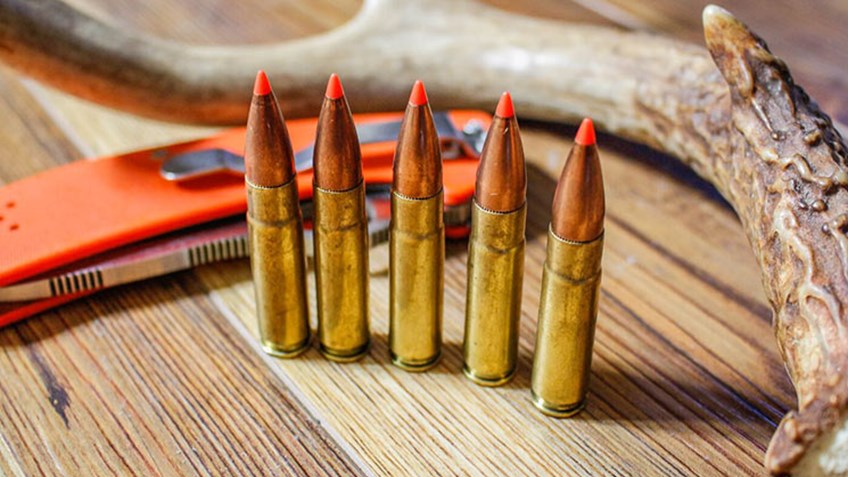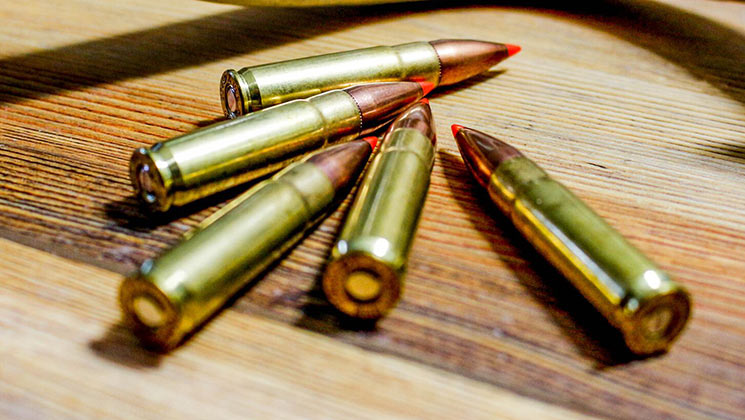This is a big question around the whitetail woods: how well can the AR-15 serve as a viable hunting rifle when chambered for this round? Here’s one answer… Read on!
SOURCE: NRA Publications, American Hunter
by Philip Massaro
The AR-15 platform has been modified and fiddled with for quite a while, and has its own series of cartridges designed specifically to function within the parameters of the rifle. The 6.8 SPC, the .458 SOCOM, the .50 Beowulf — all were built to give the AR-15 a different level of performance than the standard 5.56 NATO/.223 Rem.
There is also no doubt that .30-caliber cartridges are, have been, and probably will remain America’s favorite. So many cartridges have been modified to hold .30-caliber bullets that I have almost lost count. The .300 AAC Blackout is the cartridge built to function in the AR-15 platform, and with its design comes a different mindset, as the cartridge is called upon to fill a special role.
As a hunting cartridge, the .300 BLK certainly doesn’t look like one of the usual suspects: it is a stubby little guy, definitely lacking the look of a long-range cartridge. That’s fine, because the Blackout was never designed to fulfill that role. Perhaps a bit of history is warranted:
The Blackout’s roots are spread in the soil of the U.S. Military, which was looking for a round that would give better sub-sonic capabilities than their suppressed 9mm carbines, especially for close-in work. With some modification of a wildcat cartridge — namely the .300 Whisper — the .300 Blackout was delivered by Advanced Armament Corporation. The case itself can trace its roots all way back to the .222 Rem., through the .221 Fireball case also formed from that platform. It was designed to fit in a standard 5.56mm AR-15 magazine in double-stack configuration, yet use the long 220-grain .308 caliber bullets for subsonic performance. The Blackout did just that — pushing those 220-grain slugs at 1010 fps — but also did very well with the lighter bullets. That short case will push 125- and 130-grain bullets to a muzzle velocity of around 2200 fps — certainly no speed demon, but enough to get the job done on military targets. It functions perfectly through the AR platform, with one caveat: any ammunition that uses the sleeker-ogive bullets will actually chamber in the .223/5.56mm rifles, and that can pose one helluva problem should the ammo be confused. Please keep them separated!
In the the deer woods, the .300 AAC is an acceptable choice. If ranges are kept around 100 yards — much like the .30/30 WCF — things should go right for you. Were I using a Blackout on a deer hunt, I’d most definitely choose a premium hunting bullet in the 125- to 135-grain range, as they’ll produce the proper terminal ballistics. Those heavy 220-grain slugs are simply moving too slowly to give reliable expansion, and will more than likely whistle on through like a solid, resulting in a wounded or lost animal. No one wants that.

Ammunition choices are pretty broad now. As said, you’ll want to keep your hunting distances within reason, and choose a bullet that will expand reliably at the furthest distance you expect to take an animal with the Blackout — the range where that bullet will slow down. I’m not one of those who gets hung up on energy figures — where the commonly accepted figure of 1,000 ft.-lbs. to kill a deer came from, I don’t know — but you definitely need reliable expansion in order to kill effectively. Looking at just a few, Hornady loads the 135-grain FTX bullet at a muzzle velocity of 2,085 fps, and this will make a great hunting round. They also load their 110-grain GMX — an all-copper, polymer-tipped bullet — that will also get the job done well, again, providing you use it within reasonable ranges. Barnes builds their VOR-TX Blackout ammo around the 120-grain monometal TAC-TX bullet; Barnes worked very hard to deliver a bullet that is plenty accurate and yet gives good expansion and penetration.
The whitetail deer has suffered from guinea-pig status; I know hunters who seriously use calibers ranging from .17 Rem. all the way up to the .450 No.2 Nitro Express to make their venison, with varying levels of success. The whitetail is so prolific that, like feral hogs, sportsman tend to experiment with varying calibers and bullet weights. A good bullet, like that GMX or TAC-TX, at the lighter .30-caliber weights, will get the job done, and that’s been pretty well proven. Considering the Blackout’s trajectory, you’ll want to limit the range to 100 or 125 yards. To obtain a 200-yard zero with the Hornady FTX load, you’ll need to be 5 inches high at 100, which is a bit drastic. Perhaps a 100-yard zero, or 1 inch high at 100, where you’d be in vitals at 125 yards, makes more sense.
So, is the Blackout the perfect deer cartridge? It’s no .308 Win., but I that within 100 yards it’s a better choice than any .22-caliber centerfire. The choice is up to you, but if I were handed an accurate Blackout for a hunt in the northeast woods, I wouldn’t hesitate to use it, provided it was loaded with a good, sensible bullet.
Check out AAC choices at Midsouth HERE









